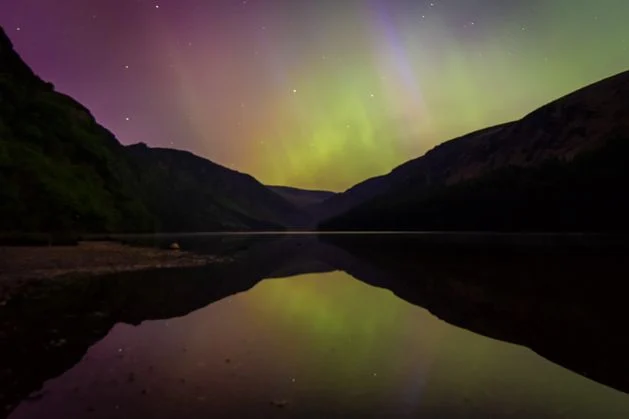Huge solar storms on surface of the Sun bring Northern Lights to Irish skies

The light show is predicted to start late this evening, experts say, and again early tomorrow – with more possible late tomorrow.
It all began with the largest solar flare of the year, just before 10am on Tuesday, when a colossal swollen sunspot on the Sun’s surface suddenly snapped.
A solar storm is a sudden discharge of material full of charged particles and swirling magnetic fields from the Sun’s surface.
Meanwhile, a solar flare is an explosion that emits light and blasts a solar storm away from the Sun.
Tuesday’s flare had an immediate impact 100km above our heads.
“The so-called ‘ionosphere’ became quite disturbed during this period and caused interruptions in radio communications and navigation systems over parts of Europe and Africa,” said Professor Peter Gallagher, Head of Astronomy and Astrophysics at the Dublin Institute for Advanced Studies (DIAS).
“This is the largest flare this year, and one of the largest of this solar cycle. The flares that produced the really bright Northern Lights seen in Ireland last May and October were smaller,” said Professor Gallaher.
Parts of Europe and Africa felt the disruption almost immediately with interruptions reported in radio communications and aircraft navigation systems across the two continents.
Solar flares are tied to the solar cycle – a roughly 11-year rhythm in which sunspot numbers surge up to a solar maximum, and dwindle to a minimum before the cycle repeats itself.
A sunspot is a temporary, darker area on the Sun’s surface, which varies in size, and is caused by intense magnetic activity.
A flare on the Sun hurls hot gas towards the Earth which collides with our planet’s magnetic field. The Northern Lights are what happens when charged particles arrive into the upper atmosphere, and reacting with the molecules already there.
The geometry of the Earth’s magnetic field – which makes life on Earth possible by protecting us from cosmic radiation by deflecting the charged particles of the Sun – means the northernmost counties of Ireland will have the best view of the Lights.
“The Earth’s magnetic field has a shape similar to a bar magnet,” said Prof Gallagher.
“At the poles, the magnetic fields reach down to the Earth’s surface, channelling material from solar storms to the Earth’s upper atmosphere.”
“The aurora (Northern Lights) therefore usually occurs at higher latitudes. That is why people in countries such as Norway, Sweden and Canada see the aurora more frequently than we in Ireland.”
“It takes a really large solar storm to be visible from mid-latitude countries such as Ireland,” said Prof Gallagher.
Aside from their curiosity value, solar flares and accompanying space weather bring a range of earthly risks.
Bursts of radiation interfere with GPS signals, air traffic radars and satellites, while also subjecting flight crews and passengers to increased radiation, particularly those working polar routes.
Flights can be disrupted. In 2003, for example, flights over Greenland were grounded after an especially fierce solar storm.
In Ireland, modern precision agriculture, which relies on accurate satellite positioning is vulnerable to space weather events, as are magnetic surveys and drilling operations.
The electricity grid is another concern. In 1989, Canada’s grid was cripped by solar storms.
As our own Government’s National Risk Assessment notes, adverse space weather is regarded as a similar strategic risk to extreme weather and natural disasters.
Adverse ‘space weather’ can also slow transportation networks and jeopardise power supplies – even though these cosmic disturbances begin some 150 km away from Earth.
Ireland does not participate in the Space Safety Programme of the European Space Agency (ESA) covering space weather forecasting, despite joining ESA back in 1975, one year after its founding.
“There are great opportunities for Irish companies, universities, and government agencies to win contracts from ESA to work on space weather,” said Professor Gallagher.
As society gets ever more reliant on global networks, scientists like Prof Gallagher believe that space weather forecasting must be part of the everyday meteorological service available to the Irish public.
Building a capability in such forecasting can protect critical infrastructure and inspire a new generation of researchers who want to unravel the secrets of the Sun.
The DIAS Aurora Éire initiative encourages amateur sky-watchers to submit photographs of the Northern Lights to build up a national archive of images of these rare events.
“If you do live in a city such as Dublin, Cork or Galway, go north of the city well away from any lights and stare to the north,” said Prof Gallagher.
“The aurora comes and goes over many hours, but do expect to have to wait outdoors in the cold for many hours.”
“Wrap up warm and bring a flask of hot tea. When the aurora does occur, the wait will be worth it.”
“If you do spot the aurora, please upload any photos you take to the DIAS Aurora Éire website (dias.ie/aurora-eire),” said Prof Gallagher.





